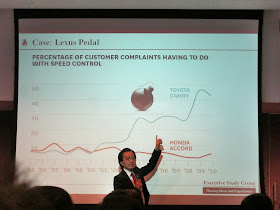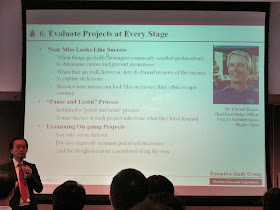Firstly, Dr. Mark Lee introduced the content of seminar included "Introduction", "Roots of Crises", "7 Strategies to Prevent Crises" and "Group Discussion".
Dr. Mark Lee explained why we have a misinterpretation of warnings. It is because mild events are often early signs. Many "Near Misses" does not consider as lesson learnt. Then Mark raised a case of BP Gulf Oil Rig Disaster in April 2010. The two of main reason were pointed out.
I) Multiple near misses preceded were ignored or misread.
II) Cognitive biases (e.g. Normalization of Deviance) conspire to blind managers to the near misses.
Then Dr. Lee discussed the roots of crises. There are bias comment of near miss in different scenarios such as Success Outcome, Near-Miss Outcome and Failure Outcome. Management usually rated the first two outcome higher rank because of no problem happened but the last outcome was blame because of failure. This Outcome Bias come from "You can't argue with success". However, it could become a Crises if enabling condition exist. These latent errors combined with enabling conditions to produce a significant failure (See diagram below).
Dr. Lee mentioned several famous cases such as Apple iPhone 4 (poor signal because of external antenna design) and Toyota Lexus Pedal problem. For Lexus Pedal case, the percentage of customer complaints were found increase from 10% upto 30% but no in-depth investigation to be done for more than 2,000 complaints of unintended acceleration among its cars. When an enabling condition occurred, the latent error trigger a crisis. Toyota recalled more than 6 million vehicles in late 2009 and early 2010.
Then Dr. Lee introduced seven strategies to prevent crises below.
1. Pay Attention to High Pressure (注意高壓)
Because of the high pressure of performance goal (e.g. tight schedules, cost, or production targets), management could like to discount near-miss signals (e.g. BP case and Columbia Space Shuttle disaster, etc.). Normalization of Deviance would happen and decision would be more easily influenced by biases.
The key management question to prevent such situation is “If I had more time and resources, would I make the same decision?”
2. Avoid Getting Used to Deviations (習非成是)
The near-miss group was much more comfortable with that level of risk for the testing of biased decisions exercise.
The key management questions to prevent such situation are “Have we always been comfortable with this level of risk?” and “Has our policy toward this risk changed over time?”
3. Uncover Root Causes Rather Than Cure Symptoms (治療根本)
When deviations are identified, we usually correct the symptom rather than its cause.
The key management action to prevent such situation is Knowledge Sharing such as learning from near misses and encouraging to report mistakes/near misses.
4. Bear Responsibility for Near Misses (無險承責)
Eventhough people are aware of near misses, they tend to downgrade their importance.
The key management action to prevent such situation is to assign people responsibility for near misses and need to give a justification of these issues.
5. Guide to Think of Worst -Case Scenarios (最壞打算)
People tend not to think through the possible negative consequences of near misses. Therefore, the key management action is to think about worst-case scenarios. Dr. Lee use the Wal-Mart case to explain how they handle crisis case. Walmart's Business-Continuity Office had carefully evaluated previous hurricane near misses of its stores and infrastructure. Moreover, Walmart will expand the staff of its emergency command centre from the usual 6 to 10 people to more than 50 which depend on escalation of emergency level.
6. Evaluate Projects at Every Stage (每段評估)
Because near misses can look like successes, they often escape scrutiny / audit / monitoring. Therefore, "Pause and Learn" Process and Examining ON-going Projects are important to avoid Outcome Bias. Moreover, knowledge-sharing workshops involving a broader group teams are useful.
7. Reward Making a Confession (獎勵坦白)
It suggested to reward people reported for uncovering near misses even though company need to pay extra cost such as stop operation.
Finally, Dr. Lee said why learning difficulty from Near Misses below.
I) Cognitive biases make them hard to see
II) Even when they are visible, leaders tend not to grasp their significance.
At the end, Dr. Lee introduced Delphi Method. The Delphi method was developed at the beginning of the Cold War to forecast the impact of technology on warfare. General Henry H. Arnold ordered the creation of the report for the U.S. Army Air Corps on the future technological capabilities that might be used by the military in 1944 (http://en.wikipedia.org/wiki/Delphi_method). Delphi Method is an iterative process to collect and distill the anonymous judgments of experts (Skulmoski, et al., 2007).
I) Cognitive biases make them hard to see
II) Even when they are visible, leaders tend not to grasp their significance.
At the end, Dr. Lee introduced Delphi Method. The Delphi method was developed at the beginning of the Cold War to forecast the impact of technology on warfare. General Henry H. Arnold ordered the creation of the report for the U.S. Army Air Corps on the future technological capabilities that might be used by the military in 1944 (http://en.wikipedia.org/wiki/Delphi_method). Delphi Method is an iterative process to collect and distill the anonymous judgments of experts (Skulmoski, et al., 2007).
Before the group discussion, Dr. Lee used NLP method to give us an exercise to choose Two of the most difficult strategies and One of the easiest strategy.
Reference:
The Centre for Logistics Technologies and Supply Chain Optimization, CUHK - http://www.logitsco.cuhk.edu.hk/
HKSTP - www.hkstp.org
Skulmoski G.J., Hartman F.T. & Krahn J. (2007) “The Delphi Method for Graduate Research”, Journal of Information Technology Education, Vol. 6, pp.1-21.













沒有留言:
發佈留言